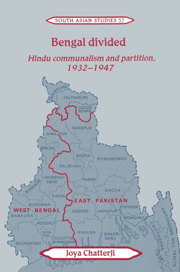Book contents
- Frontmatter
- Contents
- List of maps
- List of tables
- Acknowledgements
- List of abbreviations
- Glossary
- Map 1 Bengal districts
- Introduction
- 1 Bengal politics and the Communal Award
- 2 The emergence of the mofussil in Bengal politics
- 3 The reorientation of the Bengal Congress, 1937–45
- 4 The construction of bhadralok communal identity: culture and communalism in Bengal
- 5 Hindu unity and Muslim tyranny: aspects of Hindu bhadralok politics, 1936–47
- 6 The second partition of Bengal, 1945–47
- Conclusion
- Appendix
- Bibliography
- Index
- Cambridge South Asian Studies
6 - The second partition of Bengal, 1945–47
Published online by Cambridge University Press: 04 August 2010
- Frontmatter
- Contents
- List of maps
- List of tables
- Acknowledgements
- List of abbreviations
- Glossary
- Map 1 Bengal districts
- Introduction
- 1 Bengal politics and the Communal Award
- 2 The emergence of the mofussil in Bengal politics
- 3 The reorientation of the Bengal Congress, 1937–45
- 4 The construction of bhadralok communal identity: culture and communalism in Bengal
- 5 Hindu unity and Muslim tyranny: aspects of Hindu bhadralok politics, 1936–47
- 6 The second partition of Bengal, 1945–47
- Conclusion
- Appendix
- Bibliography
- Index
- Cambridge South Asian Studies
Summary
All-India imperatives and partition
The developments in Bengal with which this book has been mainly concerned were part of a larger canvas of all-India affairs which critically affected developments in Bengal and in their turn were affected by them. The all-India dimensions of this interplay have not been the focus of this study. Yet Bengal, in the last two years of British rule, cannot be studied in isolation from the dramatic changes which were taking place on the all-India stage. It is well known that the end of the Second World War and the coming to power of Attlee's Labour Government in July 1945 brought about a sea change in the policy of the British towards India. The first priority of the National Government under Churchill during the war had been to bring India effectively behind the war effort and to put the question of India's future into cold storage. Linlithgow's declaration of 8 August 1940 laid down as a precondition for constitutional advance that Hindus and Muslims must agree about the way forward; the failure of the Congress and the Muslim League to come to terms had justified the British in postponing consideration of the question of constitutional change until after the War. Cripps' mission in 1942 had been designed by his masters in London to be nothing more than a public relations exercise, which was not intended to succeed and Waveil's dogged attempts to put back the constitutional question onto the metropolitan agenda also came to nothing.
- Type
- Chapter
- Information
- Bengal DividedHindu Communalism and Partition, 1932–1947, pp. 220 - 265Publisher: Cambridge University PressPrint publication year: 1994
- 1
- Cited by



